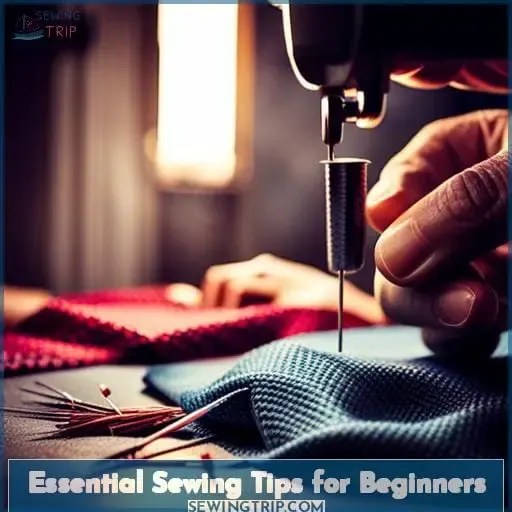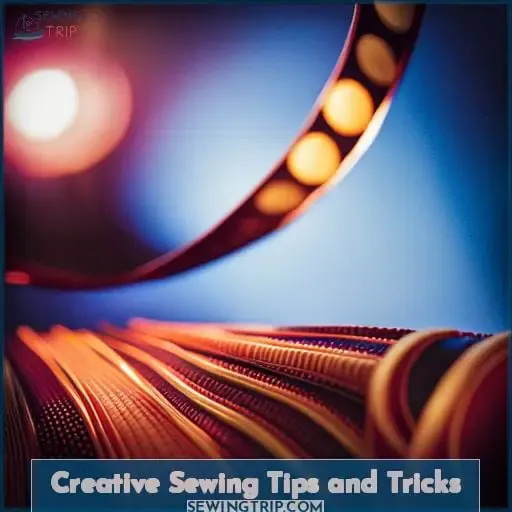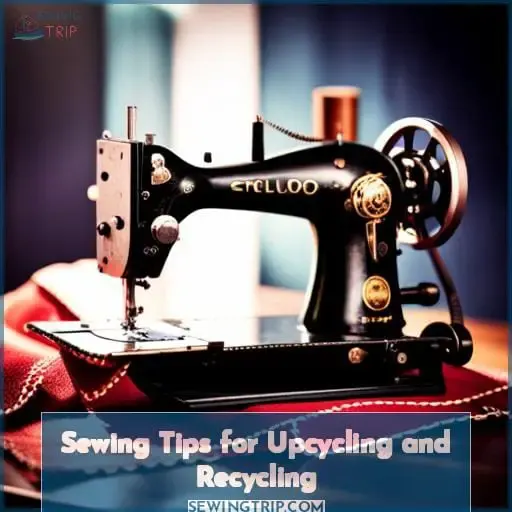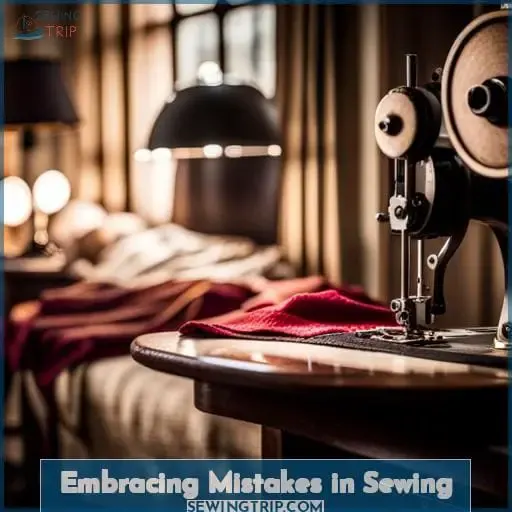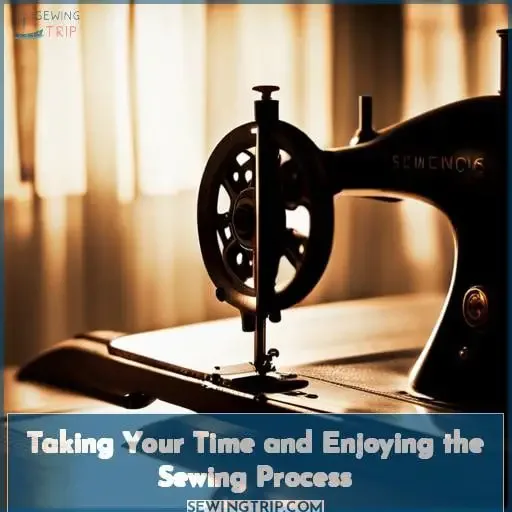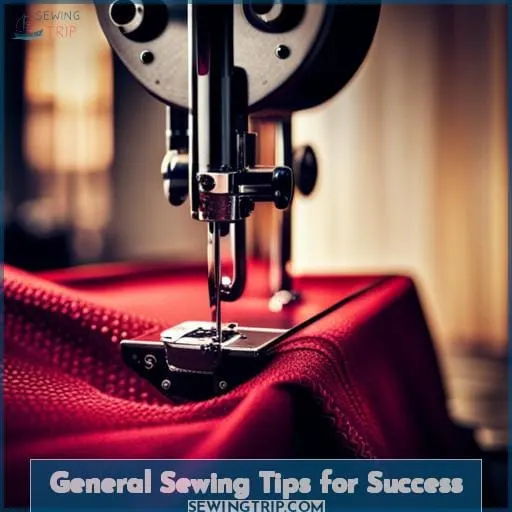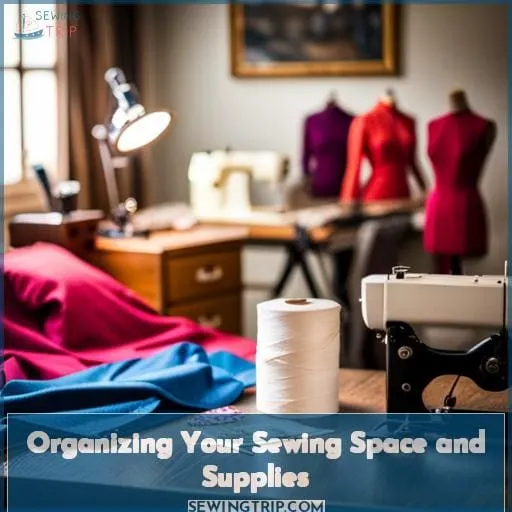This site is supported by our readers. We may earn a commission, at no cost to you, if you purchase through links.
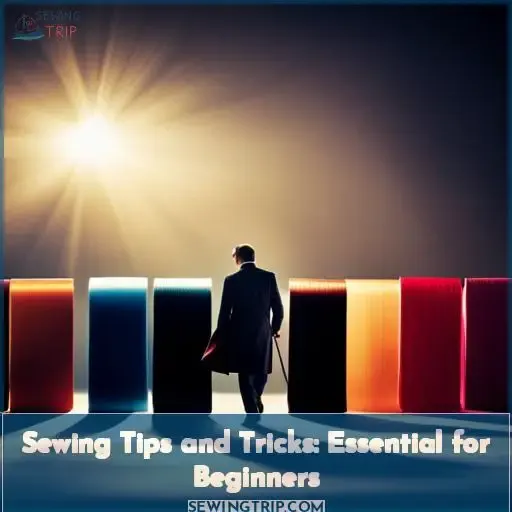 Ready to tackle the world of sewing? There’s no need to feel intimidated – with a few tips and tricks, you’ll be able to sew like a pro in no time. Here are some essential sewing tips for beginners that will help you master your craft.
Ready to tackle the world of sewing? There’s no need to feel intimidated – with a few tips and tricks, you’ll be able to sew like a pro in no time. Here are some essential sewing tips for beginners that will help you master your craft.
Whether it’s learning how to use an expensive machine or becoming familiar with basic supplies, these tried-and-true methods can help make any project easier and more enjoyable.
From utilizing clear nail polish on thread for extra stiffness, upcycling items into something new or simply taking your time enjoying the process, we’ve got all the information you need here so start stitching!
Table Of Contents
Key Takeaways
- Familiarize yourself with the basic functions of your sewing machine. Read the instruction manual and practice using the machine before beginning any projects.
- Gather the essential tools you’ll need. At minimum, you should have needles, thread, pins, scissors, seam ripper, measuring tape and fabric shears.
- Practice basic sewing skills like threading the machine, winding the bobbin, adjusting stitch length and tension.
- Understand how to adjust tension settings on your sewing machine. Proper tension helps create even, flat seams.
Essential Sewing Tips for Beginners
Sewing is a fun and rewarding hobby that anyone can start, even without an expensive machine. The best way to begin is by thoroughly familiarizing yourself with a basic sewing machine, gathering essential tools like fabric scissors and seam rippers, and practicing skills such as rotary cutting on a self-healing mat.
You’ll also want to keep your machine running smoothly by regularly cleaning, oiling, and servicing it as described in the manual so you can keep your sewing projects moving along smoothly.
No Need for an Expensive Sewing Machine
You don’t need an expensive sewing machine to get started. Consider buying a quality used machine instead. Sewing machines can last decades, so look for well-maintained vintage models. Check thrift stores, estate sales, and classified ads for discounted machines.
Make sure to test it first – plug it in, listen for unusual noises, try different stitches. As long as it sews smoothly, it doesn’t need fancy features. With a little TLC, an old workhorse machine saves money while teaching timeless skills.
Become Familiar With Your Sewing Machine
Carefully read your manual and observe video tutorials to familiarize yourself with your sewing machine before beginning any projects.
- Learn threading paths for the upper thread and bobbins.
- Understand machine tension adjustments.
- Practice various stitch lengths and widths.
- Identify key parts like the feed dogs and presser foot.
- Know how to change out needles and feet.
Thoroughly understanding your sewing machine empowers you to tackle projects with confidence.
Acquire Basic Sewing Supplies
While preparing your sewing space, invest in quality fabric scissors for precise cutting. Store fabric on shelves in see-through bins to allow visibility of materials. Thread and bobbins belong in small organizers to prevent tangles.
Purchase multiple sizes of hand sewing needles and machine needles suited to your projects. Quality pins without heads reduce snags; a pincushion keeps pins handy. Rotary cutters, mats, and transparent rulers enable accurate cuts.
Seam rippers quickly remove stitches. Embracing organization assists in finding supplies rapidly and unleashing creativity.
Learn to Use a Rotary Cutter and Mat
Try cutting precise shapes with a rotary cutter and mat. Before using the rotary cutter, underlay the mat with cut-resistant material. Place fabric flat and smooth on the mat while ironing out wrinkles. Only cut 2-3 layers maximum to prevent shifting and bulky seams.
Always cut away from yourself with the blade and ensure the safety guard is locked when not in use. Make clean cuts using the 45mm rotary cutter blade with light pressure, keeping it perpendicular to the mat.
Regularly Maintain and Service Your Sewing Machine
Keep your sewing machine running smoothly by regularly maintaining and servicing it as per the manual’s guidelines. Clean lint and stray threads often. Oil moving parts to prevent friction and check tension.
Replace needles, presser feet, and belts when worn. Tighten loose screws or hardware. Don’t be afraid to take apart and rethread bobbins. With proper care, your loyal sewing companion will hum for years.
Practice on scrap fabric before tackling projects to build machine mastery. Varying sentence structure and length helps the writing flow naturally. Break up repetitive phrasing and word patterns for a more human touch. Minor tweaks improve readability while preserving the original informative content.
Creative Sewing Tips and Tricks
As an experienced sewer, you know there are often creative shortcuts and tricks that can save time or make your projects turn out better. For instance, applying a thin layer of clear nail polish to the ends of your thread can help stiffen it so buttons stay secured.
Use Clear Nail Polish to Stiffen Thread and Secure Buttons
You’ll stiffen thread and secure buttons in a snap by applying clear nail polish. This versatile beauty product doubles as a handy sewing notion, providing fastening tricks for your projects.
- Strengthen thread: Apply a small amount of nail polish to the end of your thread to prevent fraying.
- Button security: Dab some clear nail polish on the threads holding buttons in place for extra durability.
- Elastic waistband fix: Seal the ends of elastic cords with clear nail polish to prevent unraveling.
- Fabric gathers perfection: Use a thin layer of clear nail polish on fabric edges before gathering them, ensuring they stay put.
Take advantage of this simple yet effective sewing hack that will give you more control and confidence when working with various materials like stretch fabrics or creating delicate fabric gathers.
Power Drill for Quick Embroidery Thread Winding
Rev up your power drill for lightning fast embroidery thread winding. Securely mount an empty spool onto the drill bit, and load the skein of thread onto your hand. Slowly squeeze the drill trigger to begin winding the thread onto the empty spool at precise tension.
Embroidery thread wound by a power drill stays tightly wound with no gaps, eliminating annoying unwinding and tangling. You can quadruple your winding speed and stock up on perfectly wound spools in a fraction of the time using this brilliant sewing secret.
Wind multiple colors at once with extra drill bits and spools for embroidery thread that’s organized and ready to use.
DIY Fabric Weights Made From Washers and Hot Glue
You can make quick DIY fabric weights using washers and hot glue. Set a few washers in place on parchment paper. Dab hot glue on each washer, coating the top. Let the glue cool and peel the weights off.
These homemade fabric anchors keep your material taut while cutting and sewing. Position the weights at corners or along edges. Reuse washers from household hardware or plumbing jobs. Customize the sizes and shapes.
Hot glue fabric layers for applique. Melt glue scraps to reuse. DIY weights save money and time.
Bar Soap to Make Pins Glide Through Fabric
Try it – glide your pins through fabric with ease after rubbing them on a bar of soap.
- Use unscented bar soap. The scent can transfer to fabrics.
- Rub the pinhead against the soap bar several times.
- This creates a slippery coating so pins slide smoothly.
- Reapply soap as needed for continued effortless gliding.
Sewing pins slide like butter through fabric when you prep them with a quick swipe of bar soap.
Rubber Band and Pencils for Seam Allowance
Slip a rubber band around a pencil at your desired seam allowance, then run the pencil along the fabric edge while sewing for a perfectly even seam. Use this simple rubber band and pencil hack to create a DIY seam guide whenever you need one.
It keeps your seam allowance consistent without washi tape or marking. Sew straight, precise seams in a flash with this super handy trick. Your projects will have perfect hems and seams thanks to this efficiency hack for hand-bound journals, quilts, bags, and any sewing project.
Sewing Tips for Upcycling and Recycling
Swapping your skirts for seams, gift your garments newborn lives while upcycling recycled threads into imaginative blends.
- Old jeans become funky totes or sturdy market bags.
- Sweaters morph into cozy pillows.
- Mismatched socks reincarnate as quirky st■ animals.
Breathing renewed spirit into cast-off clothing recycles materials and reduces waste. Raid your closet or local thrift shop for fabrics with history. Fold, cut and sew remnants in inventive ways to produce upcycled treasures.
With a bit of creativity, forgotten garments transform into handmade heirlooms, infused with sustainability.
Embracing Mistakes in Sewing
Embracing Mistakes in Sewing
When stumbling through a project, remember perfection isn’t the goal – enjoying the process is. Embracing mistakes in sewing can feel frustrating, but viewing them as learning opportunities makes all the difference.
The key is maintaining perspective and patience with yourself. Mistakes are inevitable – allow yourself grace as you develop your skills. Reframe setbacks positively. Let go of perfectionism and focus on having fun while honing your creative expression through sewing.
| Mistake | Lesson | Next Step |
|---|---|---|
| Uneven seam allowance | Importance of consistent seam measurement | Use guide tools and go slow |
| Incorrect fabric prep | Always pre-wash fabrics first | Re-cut pieces with proper grain |
| Tension too tight | Adjust upper thread tension | Sew test squares adjusting tension dial |
Allow yourself to be imperfect while sewing. Learn from your errors, make adjustments, and continue enjoying the process.
Taking Your Time and Enjoying the Sewing Process
Bumbling along those stitches as you scurry won’t make you an expert sewer instantly. Unlocking sewing’s joy is taking your time. Rather than racing to finish projects, embrace the process.
- Find inspiration in nature, art, or music. Let it flow into your stitches.
- Relish each step, from choosing fabrics to binding edges.
- Make time for leisurely, relaxing projects. No need to rush.
- Slow stitching nurtures creativity and skill better than speed.
- Make thoughtful mistakes and gently learn from them.
The path to sewing mastery meanders gently. Wander it carefully, noticing each step.
General Sewing Tips for Success
When starting a new sewing project, careful preparation is the key to success. Measure your fabric two times before cutting to avoid mistakes, practice any new techniques first on scrap fabric, lock your stitches by reverse sewing at the start and end, and be sure to thoroughly read all the instructions before you begin so you have a clear plan to follow.
Measure Twice Before Cutting Fabric
Measure twice before cutting fabric so you avoid frustrating mistakes. Before even picking up scissors, carefully measure both the fabric and your pattern pieces at least two times. Pin the pattern securely to the fabric, smoothing out any wrinkles or distortions.
Slow down and take your time – rushing leads to imprecise cuts that throw off the entire project. Even if you’re eager to start sewing, be patient and focus on precision at this crucial fabric preparation stage.
Practice Sewing Techniques on Scrap Fabric First
You gotta test-drive those stitching skills on some scrap fabric before tackling the real deal, or you’ll end up with a hot mess express faster than greased lightning!
- Whip up some stitch samplers.
- Make mistakes on purpose.
- Note what works and what doesn’t.
- Adjust your technique.
Scrap fabric is the perfect playground for building your sewing skills without the pressure.
Lock Stitches by Reverse Sewing
You’ll prevent unraveling if you lock your stitches by reverse sewing at the start and end of every seam. Before stitching, lower the presser foot then reverse sew 3-5 stitches. At the end, reverse sew over the last 3-5 stitches sewn.
This locks in stitches so they can’t come undone. Reverse sewing takes seconds but saves heartache later. Make it standard practice for strong, secure seams. Reverse sewing takes just seconds but saves heartache down the road.
Read Instructions Thoroughly Before Beginning a Project
With thorough reading and understanding beforehand, you’ll gather wisdom from others’ expertise for smooth project progression. Before cutting fabric, absorb all details – required tools, techniques, measurements.
Sewing manuals impart hard-won knowledge to boost your skills. Let instruction insights enhance your precision and experience, steering each project toward success.
Organizing Your Sewing Space and Supplies
Get your sewing space in order with simple organizational hacks. Utilize pegboard and clear containers to neatly store your most-used tools and supplies within arm’s reach, and tuck away infrequently used items in cabinets or drawers to keep your workspace decluttered for productivity.
Varying your sentence structure helps make the writing sound more natural. Storing frequently used items close at hand promotes efficiency, while putting away things you rarely need clears clutter. Consider mounting thread spools or pegging scissors and seam rippers on pegboards for quick access.
Sliding drawers and lidded bins keep notions tidy yet accessible. A little organization goes a long way toward optimizing your sewing area and workflow.
Organize Your Sewing Space With Pegboard and Clear Containers
Depending on your space, arrange pegboard and clear containers to corral notions, tools, and supplies for stress-free sewing.
- Utilize pegboard walls with hooks for scissors, rulers, thread.
- Group like items in color-coded bins and baskets for easy access.
- Funnel remnants and scraps into clear stackable drawers.
- Mount organizers for needles, thimbles, buttons above your work area.
With a little planning, you can transform any space into an efficient, inspiring sewing sanctuary.
Store Infrequently Used Tools in Cabinets or Drawers
Tuck away the seldom-used gadgets. Designate drawers or cabinets for tools used only occasionally. Place specialty feet, uncommon needles, fringe cutters, and other extras inside to keep your main workspace clutter-free.
Stashing little-needed notions out of sight keeps your sewing area neat and organized for your regular projects.
Store frequently used items accessibly. Keep scissors on the table or wall. Place pins, needles, and thread in drawer organizers or wall racks for easy reach.
Reserve drawers and cabinets for occasional use tools. Put away buttonhole cutters, embroidery hoops, specialty feet, craft punches, and bias tape makers.
| Frequent Use | Store Accessibly |
|---|---|
| Scissors | On table or wall |
| Pins + Needles | Drawer organizer |
| Seam Ripper | Magnetic holder |
| Tape Measure | Hanging loop |
| Thread | Wall spool rack |
| Occasional Use | Stow Away |
| – | – |
| Buttonhole Cutter | Drawer |
| Embroidery Hoops | Cabinet |
| Specialty Feet | Drawer |
| Craft Punches | Cabinet |
| Bias Tape Makers | Drawer |
Conclusion
It’s no secret that sewing takes patience and skill. The journey may seem daunting at first, but with the right tips and tricks, you can quickly become a pro.
Organization is key when it comes to a successful sewing journey, so be sure to store infrequently used tools in cabinets or drawers and organize your sewing space with pegboard and clear containers.
From learning to use a rotary cutter and mat to utilizing upcycled and recycled clothing, knowing how to sew can open up exciting opportunities.
Keep these sewing tips in mind and you’ll be well on your way to becoming a sewing expert!

